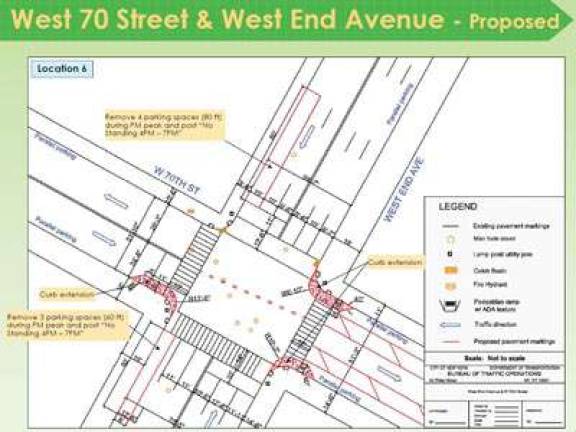Traffic Study Focuses on a Safer Upper West Side

Last week, the city's Department of Transportation unveiled the long-awaited results of a comprehensive traffic study of the Upper West Side. Manhattan Borough Commissioner Margaret Forgione presented the DOT's data and plans to the community at a forum hosted by City Council Member Gale Brewer and Community Board 7, who initially pushed for the study. The DOT first began collecting data on the Upper West Side in 2006. The study aimed to primarily address pedestrian safety, double parking, congestion, enforcement and truck traffic. Within the study area (from West 55th to 86th streets, between Central Park West and the Henry Hudson Parkway), the DOT conducted pedestrian counts at 26 locations and manual turning movement counts at 42 locations, looked at automatic traffic recording information for 18 spots, clocked travel speeds along 12 corridors, analyzed accident data for a four-year period and conducted a parking survey. The end result is a slew of recommendations, some simple and some more complex, to improve both traffic flow and safety on the Upper West Side. Many of the DOT's recommendations focus on ways to slow traffic at intersections and allow pedestrians more time to cross the street at some notoriously dangerous spots in the neighborhood. At the intersection by P.S. 199, where the DOT earlier had installed two speed humps at the adamant request of parents concerned about their children crossing the street to get to school, the new proposal suggests doing even more to calm traffic at West 70th Street and West End Avenue. The plan would create three neckdowns on corners of the intersection, as well as putting striped channeling to visually narrow the road and slow vehicles before they approach. "What we'd want to do is pick the items that have been the most concern to the community board, and also the items that are fairly easy to implement, and prioritize those at the transportation committee, so that we can try to have some quick successes," Forgione said after the meeting. The DOT will be collecting feedback on their report, and residents can write to DOT as well as to Community Board 7 to share their thoughts and weigh in on what the first priorities should be as far as making changes based on the study. Some things, like those that require only a day's work and some paint, can be done right away. Other proposals, like ones that involve changing traffic lanes, moving bus stops, installing curb extensions and creating pedestrian medians, will take more time and are not necessarily going to happen automatically. Some residents at the meeting expressed dismay over the suggestions that eliminate or limit parking spaces, for example, and others weren't convinced that changing traffic patterns would have the desired effects. "The more complex the solution, sometimes you need to be a little more deliberative about making a move, but there are some things in this study that I think you heard tonight that everybody agrees are both a priority and readily doable," said Mark Diller, chair of Community Board 7. He said that he hopes to usher through some of the easiest and least controversial measures swiftly, but knows that other measures will require more time and feedback. Council Member Brewer said that she's happy that the community can move forward with an abundance of data to back up their concerns. "To the credit of DOT, they now have some facts-who's crossing, where the traffic issues are-and that was the first step," Brewer said. "This has been a really collaborative process; this is like the sixth or seventh meeting I've been to on this process, so this is not done in isolation." The full presentation is available online at www.nyc.gov/html/dot/html/about/westside.shtml.